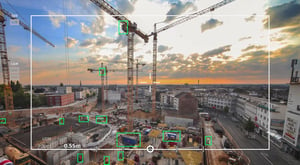In infrastructure everything tangible has a surface that can show a form of wear and tear or be damaged. Managing these assets through manual or semi-automated inspection is a tedious process. For example, inspecting the state of asphalt on a single road and marking issues for follow up can take up to five weeks. Using intelligent automation, the same road can be inspected within hours while generating actionable work orders at the same time.
Our new ebook "Employing intelligent automation for better business operations" explores how companies are already deriving value from intelligent automation.
The principle of intelligent automation applies not only to road surfaces but to any asset where the surface is visible. Underground infrastructure is visible if radar images are generated, while infrared imaging can be used to look through items. Just imagine how many processes could be automated.
Construction
The infrastructure sector, where planning and maintenance depend heavily on labor-intensive, repetitive tasks has much to gain from intelligent automation. Misalignment between planned work and reality can cost millions in damages when construction breaks down, pipes or wires are destroyed by digging or roads and waterways suddenly deteriorate to a level that puts public safety at risk.
Intelligent automation enables real-time identification and localization of anomalies while maximizing the utilization of human resources. It ensures that issues are detected before damage is caused and maintenance is performed in compliance with regulatory requirements.
Real Estate
Asset management in and around both public and commercial real estate traditionally requires a huge amount of human resources, systems, and planning. At the core of asset management processes are asset monitoring and integrity checking, followed by a set of actions to resolve issues.
An issue arises whenever an asset reaches a state that deviates from the norm as a result of natural degradation or damage. The resolution is usually to plan repairs or replacements in an existing workflow system. Innovative real estate and asset management companies have already started to automate these processes.
Machines are continuously monitoring spaces, detecting deviations, and planning actions to resolve issues. Cameras perceive spaces in real-time, collecting visual data. Machines recognize the presence and appearance of physical assets in realtime and compare their state to a historical reference or norm.
When a deviation is detected the machine leverages pre-defined rules to plan the best action for each detected issue and feeds them into an existing maintenance workflow system.
Are you interested to have more in-depth information about how intelligent automation can create more value? Download our free ebook now!

